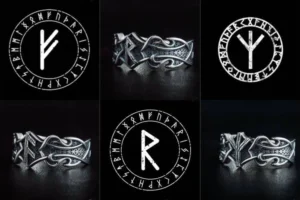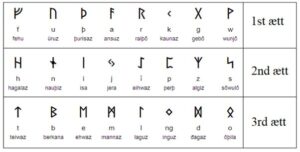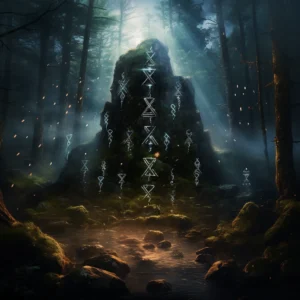The legacy of the Vikings stretches far beyond their seafaring expeditions and warrior ethos. Among their most enduring contributions to history is the enigmatic system of writing known as the runic alphabet. Carved into stones, wood, and metal, these ancient symbols served as both a means of communication and a conduit for mystical beliefs. Today, scholars and enthusiasts alike are engaged in a quest to unlock the secrets of Viking runes, delving into the language and culture of the Norsemen to reveal the rich tapestry of their written heritage.
The Origins of Runic Writing

The origins of the runic alphabet can be traced back to the Germanic tribes of northern Europe, from which the Vikings emerged. The earliest runic inscriptions date back to around the 2nd century CE, although the full development of the script occurred during the Viking Age, between the 8th and 11th centuries. Unlike the Roman alphabet with its linear progression, the runic script consists of angular characters known as “runes,” each representing a specific phonetic sound.
The precise origins of the runic symbols remain shrouded in mystery, with some scholars suggesting influences from Mediterranean scripts such as Etruscan or Greek, while others argue for indigenous development within the Germanic cultural sphere. Regardless of its exact origins, the runic alphabet evolved into a distinctive system of writing that reflected the worldview and linguistic characteristics of the Norse people.
The Structure of the Runic Alphabet
At its peak, the runic alphabet consisted of 24 characters, known collectively as the “Elder Futhark.” The term “Futhark” is derived from the first six letters of the runic alphabet: F, U, Þ, A, R, and K. Each rune not only represented a phonetic value but also held symbolic significance, often associated with natural elements, deities, or abstract concepts.
The structure of the runic alphabet facilitated both practical communication and mystical interpretation. Inscriptions ranged from mundane messages and personal names to spells, charms, and cryptic prophecies. This dual nature of the runic script reflects the multifaceted roles of writing within Viking society, serving both mundane and sacred purposes.
Deciphering the Runic Inscriptions
Deciphering the meaning of runic inscriptions presents a formidable challenge to modern scholars. Unlike languages with extensive written records and living descendants, such as Latin or Greek, the Norse language preserved in runic form is no longer spoken. Furthermore, the brevity and ambiguity of many runic texts leave ample room for interpretation.
To decipher runic inscriptions, scholars employ a combination of linguistic analysis, comparative study, and contextual interpretation. By comparing runes to known alphabetic systems and correlating them with archaeological findings and historical accounts, researchers can gradually piece together the meanings of individual symbols and reconstruct the linguistic and cultural context in which they were used.
The Legacy of Viking Runes
The legacy of Viking runes extends far beyond their historical context, continuing to capture the imagination of people around the world. From contemporary art and literature to popular culture and New Age spirituality, the mystique of the runic alphabet endures as a symbol of Nordic identity and esoteric wisdom.
In recent years, there has been a resurgence of interest in runic magic and divination, with enthusiasts exploring the symbolic meanings of individual runes and devising systems of runic interpretation for spiritual guidance and personal growth. While some dismiss such practices as mere superstition, others see them as a meaningful connection to the spiritual heritage of the Norse tradition.
Exploring Runic Symbolism in Art and Architecture
Beyond their practical use in communication, Viking runes played a significant role in the realm of art and architecture. From intricately carved wooden staves to ornate stone monuments, runic inscriptions adorned a wide array of objects and structures, serving as both decorative motifs and expressions of cultural identity. These symbols often carried deeper symbolic meanings, reflecting the spiritual beliefs and mythological narratives of the Norse worldview. Runic motifs were not merely decorative; they were infused with significance, representing concepts such as protection, strength, and connection to the divine.
In Viking art, runes were incorporated into intricate designs that adorned everyday objects as well as monumental structures. Runic inscriptions found on weapons, jewelry, and household items served both practical and symbolic purposes, imbuing these objects with a sense of magical potency and cultural significance. In architecture, runic symbols adorned sacred sites such as burial mounds and temples, acting as markers of spiritual significance and invoking divine blessings for the community.
By studying the placement and context of runic inscriptions in various artistic and architectural contexts, researchers gain valuable insights into the aesthetic sensibilities and cultural values of Viking society. Runic art and architecture not only reflect the artistic skills of the Norse craftsmen but also provide a window into their beliefs, values, and social structures. Through careful analysis of these artifacts, scholars can reconstruct the visual language of the Vikings and appreciate the rich tapestry of symbolism that permeated their material culture.
The Role of Runes in Ritual and Religion

Central to the Viking worldview was a complex tapestry of religious beliefs and ritual practices, many of which were intertwined with the use of runes. From invoking divine blessings to warding off malevolent spirits, runic magic played a vital role in the spiritual life of the Norsemen. Runic inscriptions were believed to possess inherent magical properties, offering their bearers both physical protection and spiritual empowerment. The use of runes in religious rituals was not confined to formal ceremonies; they were also employed in everyday practices such as healing, divination, and fertility rites.
Runestones, amulets, and talismans inscribed with protective symbols were commonly used as tools of magical practice, serving as tangible expressions of faith and devotion. These objects were believed to act as intermediaries between the human realm and the divine, channeling the power of the gods and spirits to influence the course of events in the material world. Through an examination of archaeological evidence and literary sources, scholars seek to unravel the intricate relationship between runic writing and religious practice in Viking-age Scandinavia, shedding light on the spiritual beliefs and rituals that shaped the lives of the Norse people. Through deeper research and dedication, new objects and their know-how are found throughout history, which you can find in various dedicated museums under the protection of an access control system from Philadelphia that you can also install in your home for added protection.
The Linguistic Evolution of Runic Writing
As a living script, the runic alphabet underwent significant changes and adaptations over the centuries, reflecting shifts in language, culture, and social dynamics. From its early Germanic origins to its later medieval manifestations, the runic script evolved alongside the Norse language, incorporating new phonetic distinctions and orthographic conventions. The linguistic evolution of runic writing can be traced through the examination of inscriptions found on various artifacts, including runestones, wooden sticks, and metal objects. The development of the language is very interesting to follow, and since Europe has a rich history, you can rent a car in Beograd and follow the history of one of the nations through the history of their unique script.
The earliest runic inscriptions are characterized by a relatively simple set of characters, known as the Elder Futhark, which consisted of 24 symbols. Over time, this alphabet underwent regional variations and innovations, giving rise to new runic systems such as the Younger Futhark and the Anglo-Saxon Futhorc. These developments were influenced by factors such as contact with neighboring cultures, changes in phonological patterns, and the adoption of Christianity. These interesting letters can be especially interesting to study who you can devote yourself to form your own unique letter in addition, the internet service provider that manages IT services in San Antonio provides its users with excellent internet with which you can explore all these and many more stories and legends that hide behind different signs.
By tracing the development of individual rune forms and analyzing their usage in different historical contexts, linguists can reconstruct the phonological and morphological features of ancient Norse dialects, shedding light on the linguistic diversity of the Viking Age. The study of runic inscriptions provides valuable insights into the evolution of the Norse language and its interactions with other linguistic traditions in the medieval period. This contributes to a better understanding of literary works from that period and their unique translation, which is especially enjoyed by young members of the Readathon school fundraiser who work hard to develop their reading hobbies.
Runic Inscriptions in Global Context
While the majority of runic inscriptions are found within the Scandinavian region, evidence of Viking contact and colonization extends far beyond the boundaries of Northern Europe. Runic artifacts have been discovered as far afield as Russia, Iceland, Greenland, and even North America, providing tangible evidence of the Norse expansion into new territories. These inscriptions offer valuable clues about the extent and nature of Viking contact with indigenous peoples and other cultures around the world. Especially interesting are the unique destinations that you can visit and find real artifacts and signs with Viking symbols drawn on them, and in order to visit these places you can move safely and comfortably after improving and diagnosing your car at an experienced transmission service in Buffalo.
In Russia, for example, runic inscriptions have been found on artifacts such as coins, weapons, and religious objects, indicating the presence of Viking settlers and traders in the region. In Iceland, runestones and other archaeological remains attest to the Norse colonization of the island during the medieval period. In Greenland, runic inscriptions have been discovered on objects ranging from tools and utensils to church bells and gravestones, offering insights into the daily lives and cultural practices of the Norse settlers. There are even various items such as wine glasses and unique instruments engraved with special symbols with extraordinary meaning that hide unique legendary stories behind them.
By studying the distribution and content of runic inscriptions in these diverse geographical settings, scholars gain valuable insights into the interconnectedness of Viking culture with the wider medieval world, highlighting the dynamic nature of cultural exchange and interaction during the Viking Age. Runic inscriptions serve as tangible evidence of the Norse presence in distant lands and provide a valuable source of information about the complexities of Viking society and its interactions with other cultures. Those who know numerous historical stories from this time are aware of all these movements and changes, and those who are not history-strong can turn to an excellent science tutor in Boulder who will help them master this and other difficult material and pass their tests.
The Influence of Viking Runes on Modern Culture
Despite the passage of centuries, the legacy of Viking runes continues to resonate in modern culture, inspiring artists, writers, and scholars alike. From contemporary adaptations of Norse mythology to the use of runic symbolism in popular media and fashion, the mystique of the Viking Age exerts a powerful hold on the collective imagination. Runes have been appropriated and reinterpreted in a variety of contexts, ranging from literature and film to fashion and design. Many of these artistic movements use the power of rune symbols to convey a unique message among people, and part of the funds even go to some noble movements, such as funding research to create the best treatment for autism so that children diagnosed with this condition receive adequate and best therapy.
In literature, the use of runic symbols often evokes a sense of mystery and antiquity, lending an air of authenticity to fictional narratives set in the Viking Age. In popular media, such as television shows and video games, runes are frequently depicted as magical symbols imbued with mystical powers, adding an element of fantasy and adventure to the story. In fashion and design, runic motifs are used to evoke a sense of Nordic heritage and cultural identity, serving as visual markers of Scandinavian aesthetics. If you join some of the excellent and advanced filmmaking courses you can learn a lot more about the different meanings of the runes on film that can be used to add to the mystique and magic of the film.
By examining the ways in which runes are appropriated and reinterpreted in modern contexts, researchers can gain valuable insights into the enduring significance of Viking heritage in the contemporary world. Whether as a source of artistic inspiration, a symbol of cultural identity, or a tool for personal expression, Viking runes continue to fascinate and captivate people around the globe, highlighting the enduring legacy of the Norsemen and their enigmatic script. The promotion of these special signs and the legends that are hidden behind them, more and more people learn about the unique and special history of the Nordic peoples, if your business also needs good promotion so that more people know about you, you can turn to an excellent Colorado Springs SEO company that will create a successful promotion plan for zou.
Challenges and Controversies in Runic Studies

While the study of Viking runes holds great fascination, it is not without its challenges and controversies. From issues of authenticity and provenance to debates over the interpretation of ambiguous inscriptions, scholars grapple with a wide range of methodological and ethical dilemmas in their quest to unlock the secrets of the runic alphabet. One of the primary challenges in runic studies is the fragmentary nature of the evidence, with many inscriptions being incomplete or damaged, making interpretation difficult. If you want to personally explore these unique symbols, you can rent a car in Beograd and visit some of the unique places in Europe where the indigenous population will introduce you to the deeper legends associated with the signs and letters used throughout history.
Another challenge is the lack of standardized transliteration and transcription methods, which can lead to inconsistencies in the interpretation of runic texts. Different scholars may interpret the same inscription in different ways, leading to conflicting interpretations and debates within the academic community. Additionally, the use of runic symbols in contemporary contexts, such as New Age spirituality and neo-paganism, has raised questions about cultural appropriation and the misuse of ancient symbols for modern purposes. These symbols, although not yet fully explored, are increasingly used to decorate certain events and bring a special addition to a festival and experience such as special pet expos where one wants to emphasize the strength and good origins of the participating dogs or other social gatherings.
Despite these challenges, scholars remain committed to advancing our understanding of Viking runes in a responsible and nuanced manner. By engaging in rigorous scholarly inquiry and fostering dialogue within the academic community, researchers strive to address these challenges and contribute to our knowledge of Viking culture and history. Through interdisciplinary collaboration and a spirit of inquiry, we can unlock the secrets of Viking runes and preserve their legacy for future generations to appreciate and explore. Research into these symbols is increasingly successful due to the excellent development of the technology necessary for this, which has gone hand in hand with the development of telecommunications as well as the great demand for millimeter wave products found in telephones and radios.
Conclusion
In conclusion, the study of Viking runes offers a fascinating glimpse into the linguistic, cultural, and spiritual heritage of the Norsemen. From their origins in the Germanic past to their enduring legacy in the modern world, runic inscriptions continue to captivate the imagination of scholars and enthusiasts alike. As we continue to unravel the mysteries of the runic alphabet, we gain valuable insights into the complexities of Viking society and the rich tapestry of human history. Through interdisciplinary collaboration and a spirit of inquiry, we can unlock the secrets of Viking runes and preserve their legacy for future generations to appreciate and explore. Moreover, the fascination with Viking culture extends to the realm of fashion, with a growing market for authentic veteran apparel inspired by Norse designs and symbols.